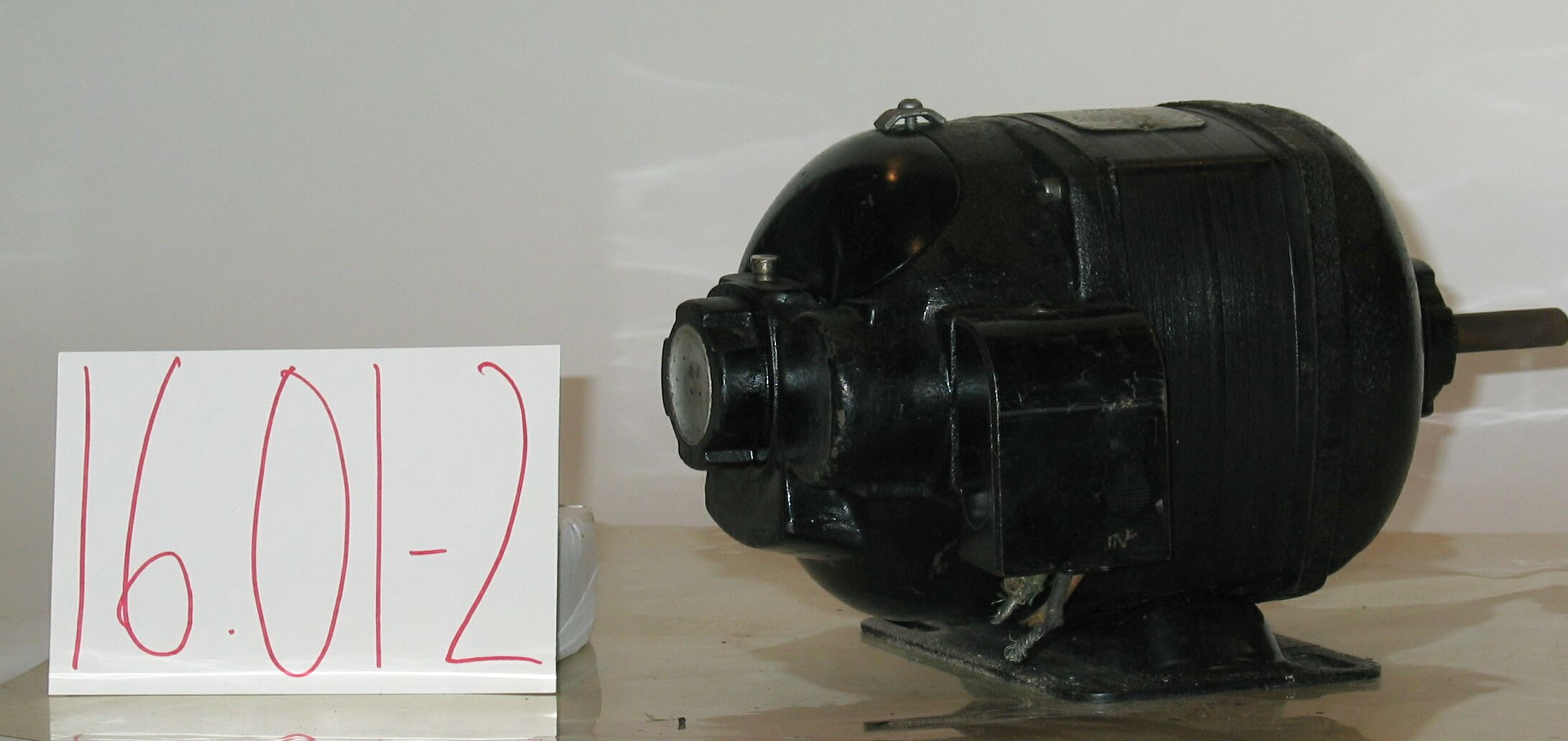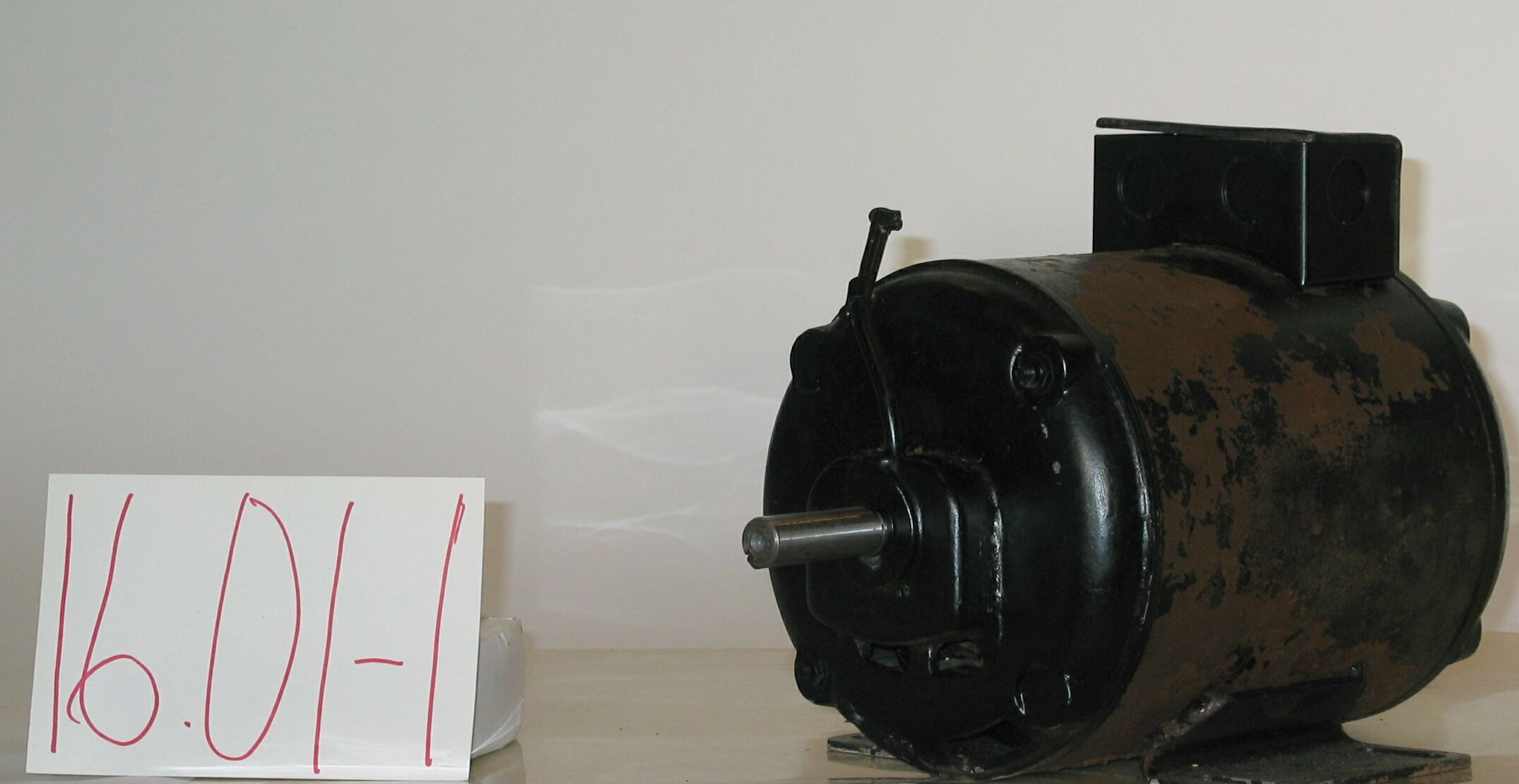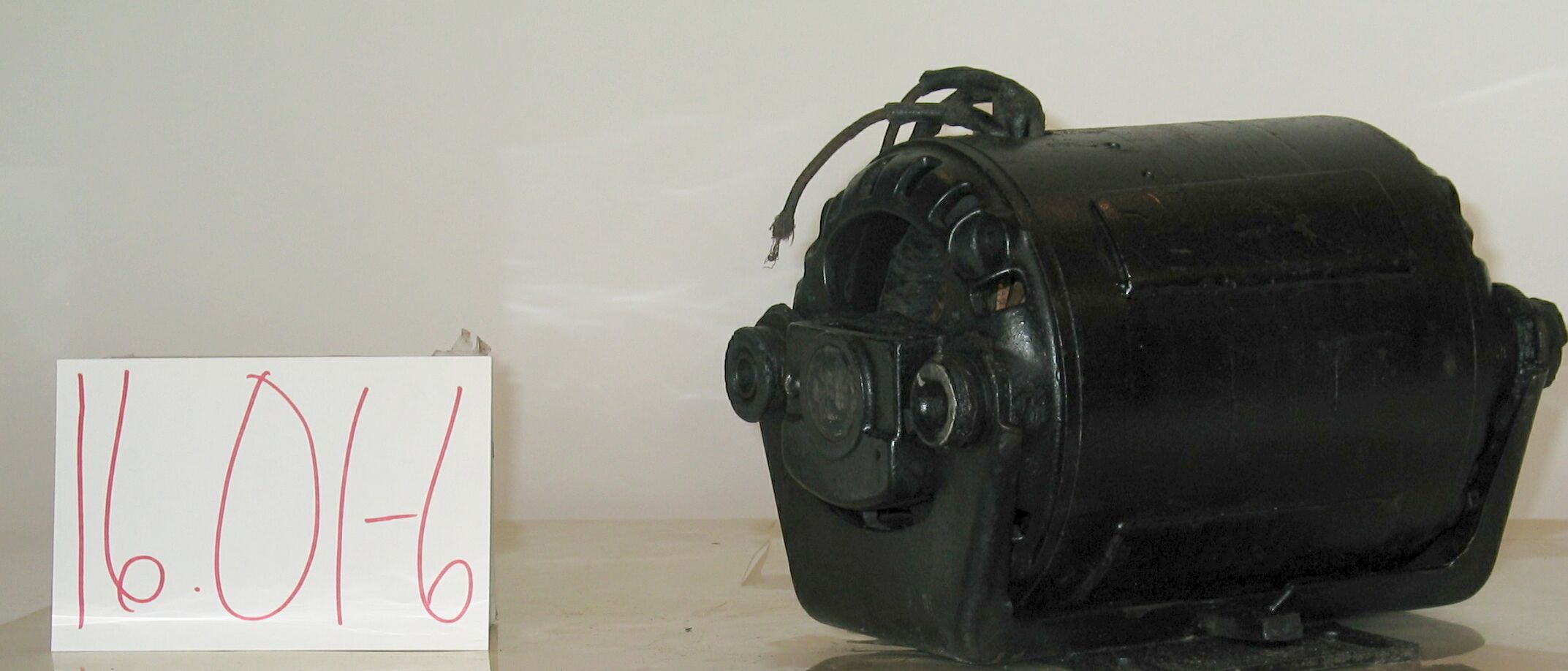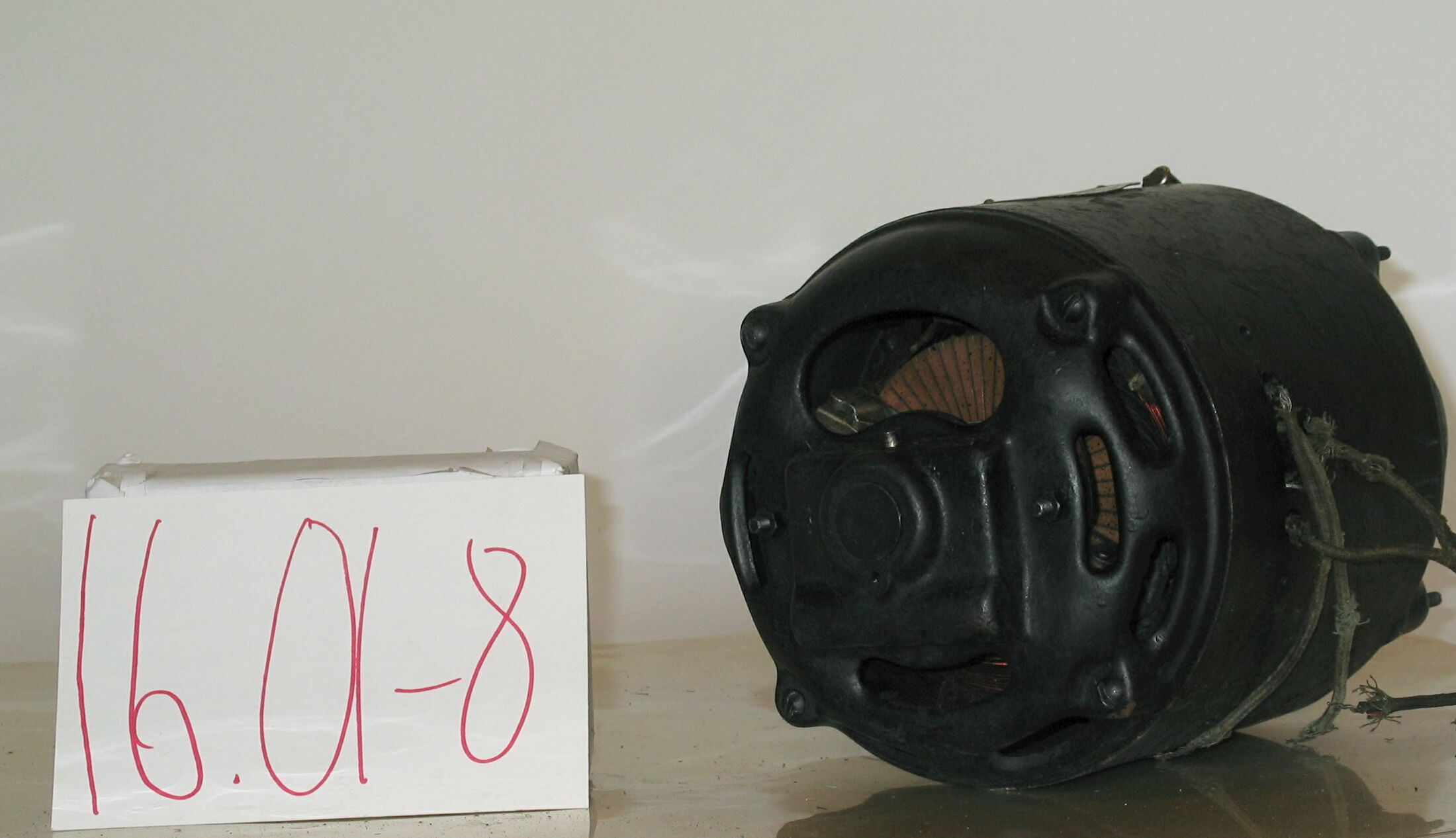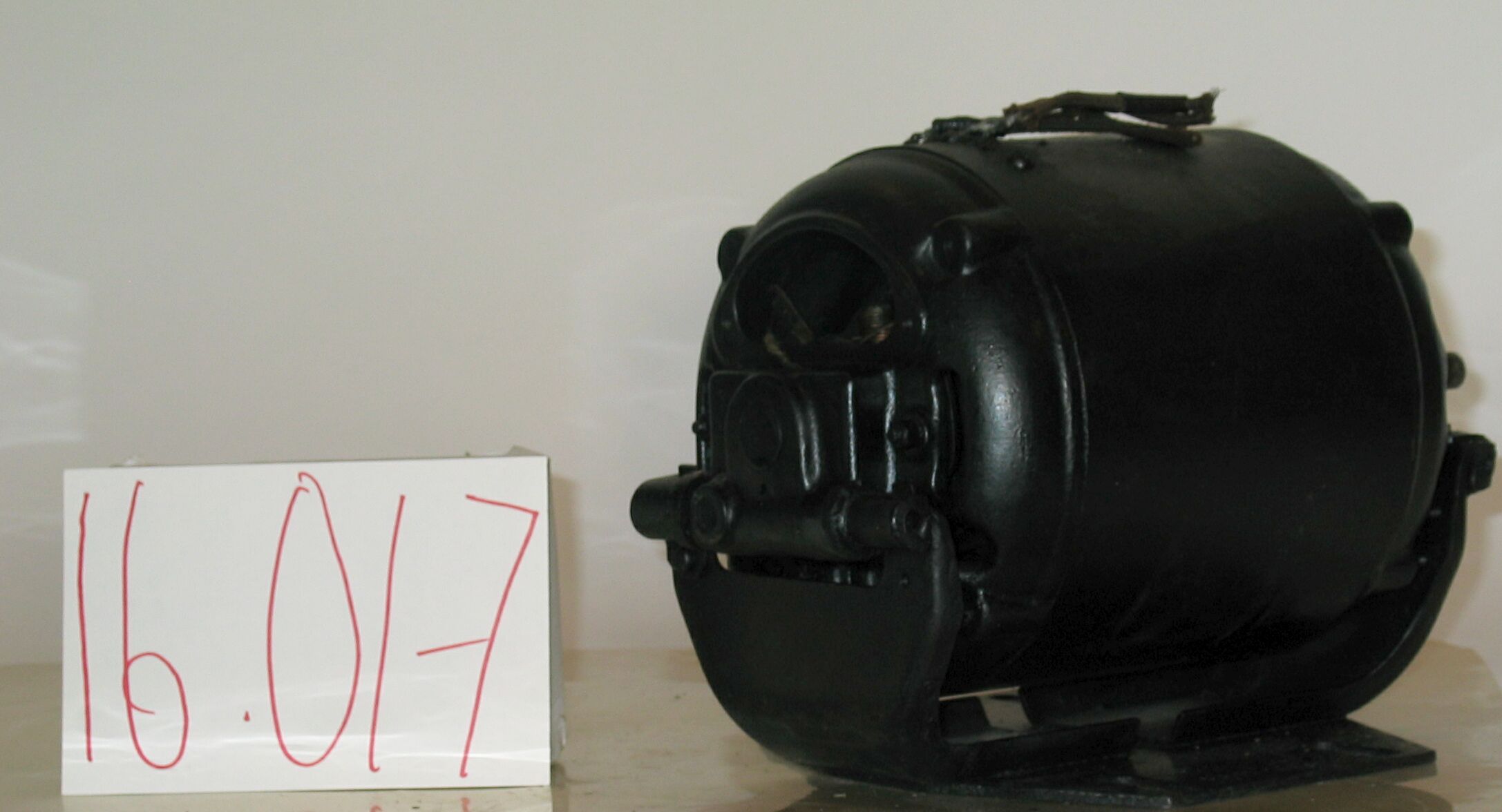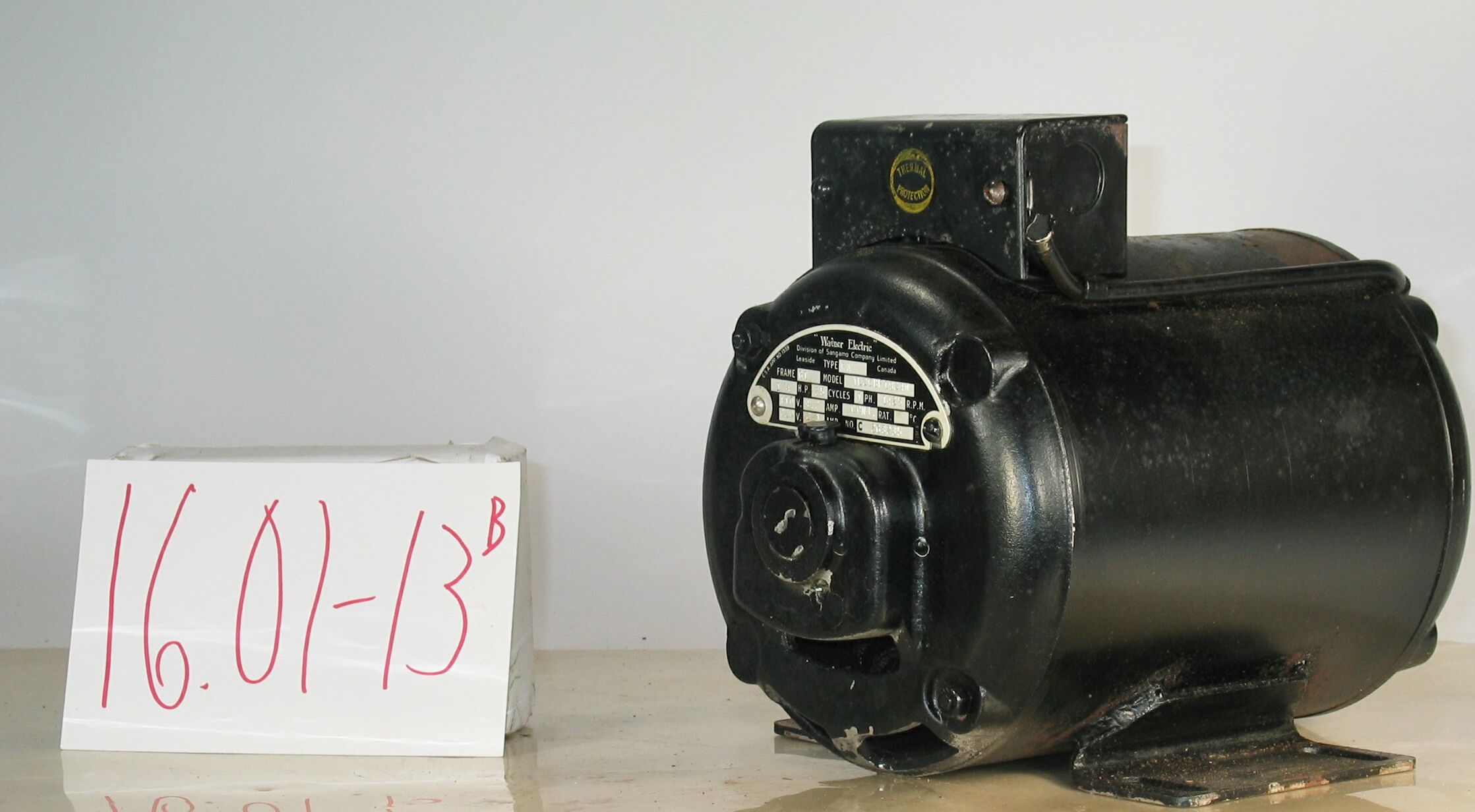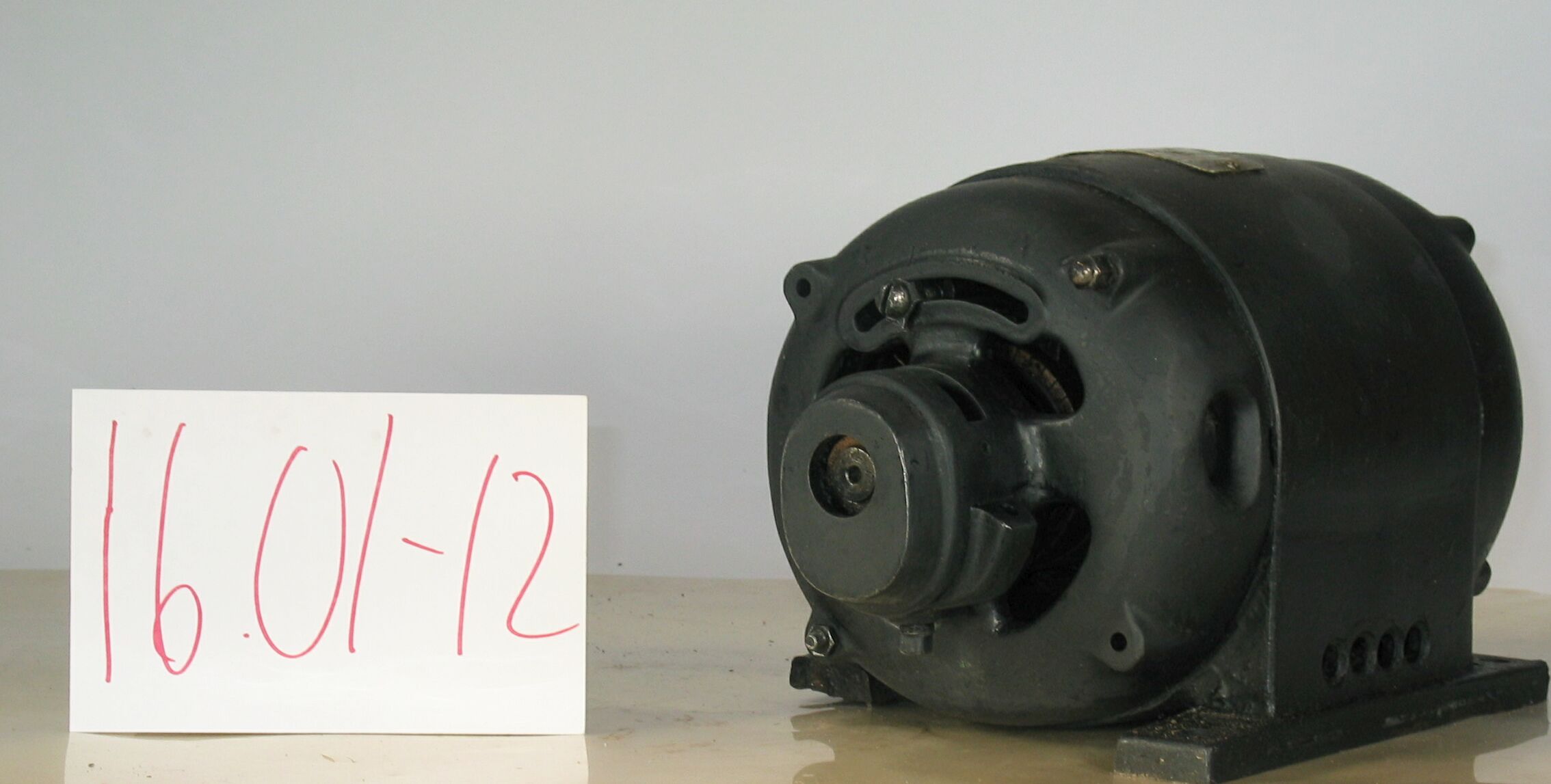16.01-13C: Wagner 1947 25 Cycle Repulsion Induction Motor
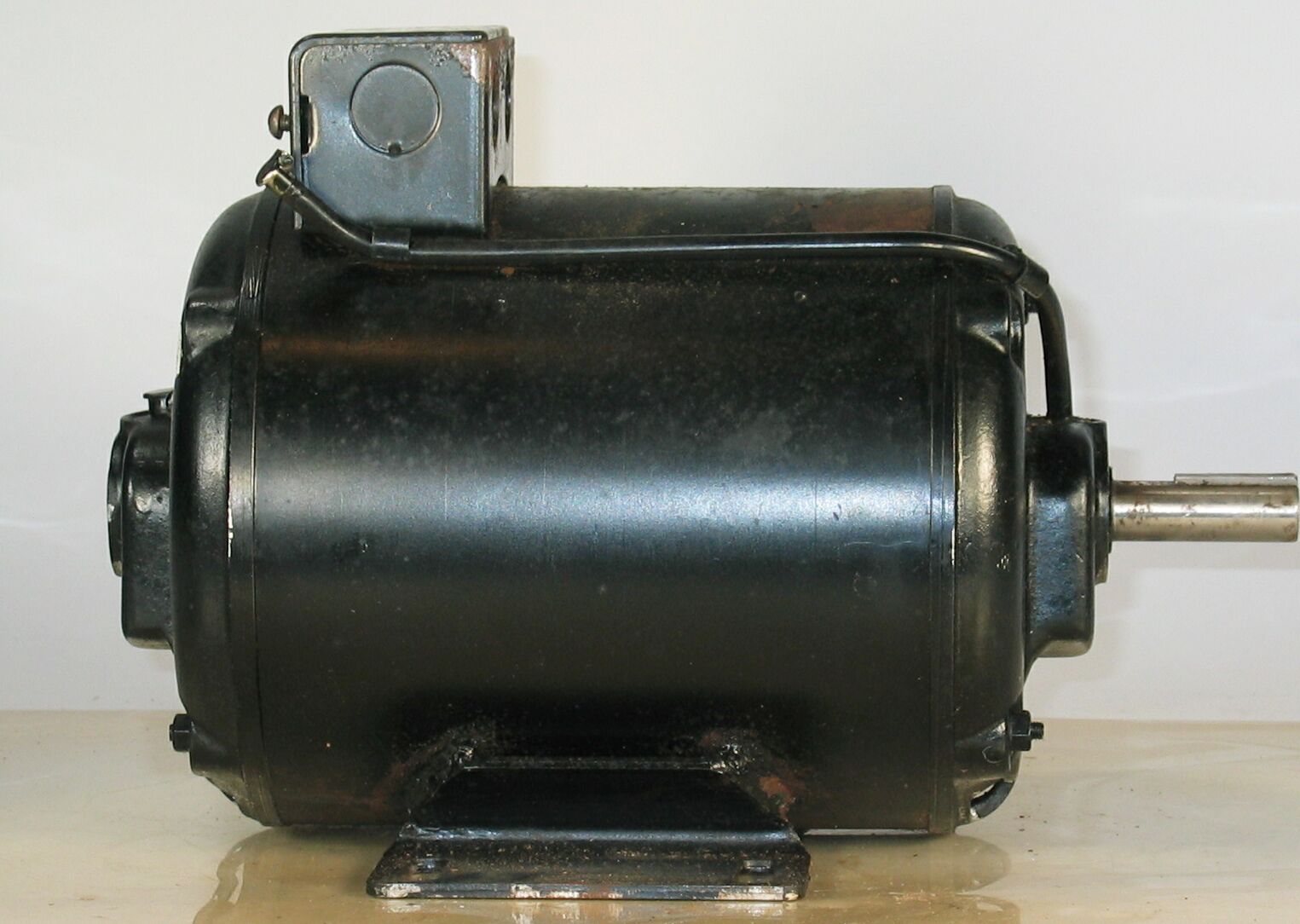
| HHCC Accession No. 2006.183 | HHCC Classification Code: 16.01-13C |
|---|
Description:
A mid 20th century, classic ‘ HP, repulsion induction motor with inherent overload protection and automatic reset, part of a rare set of three 25 cycle motors escaping frequency standardization in 1948. They define new standards of practice, telling many stories of the explosion of small commercial refrigeration applications, which were enabled in the 1940’s through 50’s, changing the lives of Canadians forever, Wagner, new and unused, Circa 1947 [see also ID# 305, 306]
Group:
16.01 Electric Motors - Single Phase, Repulsion Induction
Make:
Wagner
Manufacturer:
Wagner Electric Mfg. Co. of Canada Ltd., Div. of Sangamo Co., Ltd. Leaside Ont.
Model:
YL26BF1924N, Type RA
Serial No.:
2625059
Size:
13 x 8 x 9’h
Weight:
36 lbs.
Circa:
1947
Rating:
Exhibit, education, and research quality, illustrating the engineering and construction of a mid 20th century Canadian made FHP motor, with inherent, automatic overload protection, the standard of practice for small commercial refrigerator applications in the 1940’s through 50’s, new and un-used.
Patent Date/Number:
Provenance:
From York County (York Region) Ontario, once a rich agricultural hinterlands, attracting early settlement in the last years of the 18th century. Located on the north slopes of the Oak Ridges Moraine, within 20 miles of Toronto, the County would also attract early ex-urban development, to be come a wealthy market place for the emerging household and consumer technologies of the early and mid 20th century.
This artifact was discovered in the 1950’s in the used stock of T. H. Oliver, Refrigeration and Electric Sales and Service, Aurora, Ontario, an early worker in the field of agricultural, industrial and consumer technology.
New and un-used motors held as new stock by T. H. Oliver, Refrigeration and Electric at the time of frequency standardization in Aurora Ont in 1948
Complete with original manufacturers warranty tags and instructions.
Type and Design:
Mid 20th century, heavy duty, repulsion induction, commutating motor, Rigid 4 bolt slotted base plate ‘Klixon’ inherent overload protector with automatic reset Classic Wagner centrifugal brush lifting, armature short circuiting mechanism 1/4 HP Dual voltage, 110-220 volts Large junction box with 1?2 inch knockouts Bronze sleeve bearings Extension oiler safety tube and snap caps Steel ferro-magnetic body, with light weight, non-ferro magnetic, alloy end bells
Construction:
Material:
Special Features:
Inherent, overload protector with automatic reset State of the art, light weight, non-ferro magnetic, alloy end bells
Accessories:
Complete with original manufacturers warranty tags and instructions.
Capacities:
Performance Characteristics:
Operation:
Control and Regulation:
Targeted Market Segment:
Consumer Acceptance:
Merchandising:
Market Price:
Technological Significance:
An artifact [artifacts] of Canadian history telling many stories of life and times, including Canadian technological innovation, dissemination and popularization of electro-motive technology:: Marking the immense engineering achievement in the development and wide spread application of elegant and affordable, FHP repulsion induction motor technology well before the mid 20th century, paradoxically on the eve of its gradual demise and replacement by capacitor start FHP technology [see code 16.02],
Representing a technological achievement that would define the standard of practice for small commercial refrigeration motor applications in the 1940’s through 50’s, prior to the popularization of capacitor start motor technology and the widespread adoption of embedded motor and compressor equipment for commercial applications, the hermetic refrigeration condensing unit, The popularization of small commercial refrigeration applications, enabled by the Wagner Type KA, a growth market in Canada in the post W.W.II years through the 1960’s, including ice cream and frozen food cabinets and merchandizers, reach-in, unitary refrigerators, display cases and merchandizers for small food stores and confectioneries ‘ enabling a veritable explosion of new food products and tastes for Canadians.
One of Canada’s truly remarkable, mega-engineering projects of the 20th century, frequency standardization in Ontario a massive, multi-million dollar undertaking affecting every corner and crevice of life in Ontario.
Repulsion induction motor technology was above all a marvel of its time, a technology born of both science and the consumer market place, a classic formula for the innovation and diffusion of popular technology, throughout the balance of the 20th century and on in to the 21st. Scientifically, the work of Faraday and many others laid much of the theoretical foundations for electromagnetic devices, the marvel of the early 20th century [much in the same way digital devices became the marvel of the early years of the 21st]. The wonders made possible by alternating current energised, rotating magnetic fields and the electric and magnetic circuitry that made them possible would soon be exploited by those interested in their application in applied electro-motive technology, including Steinnmetz and others. [See References especially #I, 2, and 5] See also ID# 296
Industrial Significance:
See also notes ID# 296
Socio-economic Significance:
Socio-cultural Significance:
Not-with-standing a major depression and two world wars the first half of the 20th century was a period of exceptional ferment in the development and popular dissemination of FHP electric motor technology. Associated with the development were a number of driving forces, mutually supporting and interacting: Scientifically, the theoretical ground work for development of an astonishing array of electrical and electro-magnet devices had been laid by the early years of the 20th century, through the efforts of Faraday and Steinnmetz, among many others, Technologically, the work of Thomas Edison, among others, laid the foundation stones on which urban and rural electrification would proceed, enabling an new era in human experience, favoured with consumer goods and services, previously unimagined,
Economically, a favourable climate for capital investment in manufacturing capacity, methods and materials emerged, part of North America’s second industrial revolution, Socially and culturally the consumer society was born, nurtured by a pent up demand for an easier, more comfortable, pleasurable lifestyle, and the sense that 20th century electrical and electro-motive technology might be able to help. The FHP electric motor, engineered for 110 volt, single-phase house current, revolutionized life in the Canadian home. It enabled an astonishing list of appliances and labour saving devices. The revolution would take place in an astonishingly short period of time - for much of urban Canada much less than a decade. The electro-mechanical mechanization of the Canadian home was accomplished for much of urban Canada by the late 1930’s. But the early 20th century wonders of household mechanization would be dependent , in turn, on household ‘electrification’ Between them electrification and electro-mechanical mechanization changed everything. Almost over night it altered what Canadians do in the course of their day, how they live and their expectations of what their world had in store for them - in labour saving devices, devices of convenience, health and safety. The fractional horsepower electric motor [FHP] became an ubiquitous part of the Canadian household by the mid 1930’s. Cyril Veinott reported, December 1938:
‘Practically every electrified home today makes use of one or more fractional horsepower motors. This kind of motor may be used in a washing machine, refrigerator, vacuum cleaner, clock, oil burner, hair drier, room heater, sewing machine, razor, health machine, fan, air conditioner, stoker, ironed, floor waxer, or food mixer. In industrial use, the number of useful tasks performed by fractional horsepower motors is legion. In the United States alone, the value of fractional horsepower motors sold amounts to approximately $50,000,000 annually.’ See reference #1
Similarly, more than half a decade earlier Daniel Braymer had commented on the proliferation of this mind and life changing technology for home electro-mechanization. He observed that what had made it all possible was the invention of single phase alternating current motor, in a number of subtypes, small quiet, self starting, reliable and affordable motors for the home, motors which were compatible with the rapid standardization of single phase, alternating current, electrical distribution systems then spreading across north America. See reference #2 Among the types of single phase alternating current motors which quickly populated the Canadian home were: repulsion induction [see Group 16.01] for heavy duty, high starting torque applications such as refrigeration appliances; capacitor start [see Group 16.02] for advanced high torque applications, requiring quiet operation; split Phase [see Group 16.04] for light duty low starting torque applications; and shaded pole [see Group 16.04] designs for small devices such electric fans. The FHP single phase induction motor, often unobtrusive, out of sight in a dark corner, has, none-the-less, been a principle foundation stone on which Canadian, popular consumer and household technology has evolved, throughout the 20th century and into the 21st - a driving force of profound, typically un-recognized, social, cultural and economic change [See reference 6]. Electro-motive technology [the FHP motor], along with electric and electronic communications technology [the telephone and broadcast radio] would invade the Canadian home starting in the 1920’s. Throughout the balance of the 20th century these technologies would trigger a vast, new, popular consumer culture, a ‘popular technological revolution’. Yet, simply because technology has so shaped the Canadian reality, it has also shaped much profound Canadian though about the technological experience, its meaning and significance for humanity. Included among the works of Canadian writers with an international reputation are: Arthur Kroker, George Grant, Ursala Franklin, Heather Menzies, among many others [See references 7, 8, 9, and 10]. From the vantagepoint of the 21st century noted Canadian writer Jane Jacobs asks, ‘Now we stand at another monumental crossroad, as agrarianism gives way to a technology-based future. How do we make this shift without losing the culture we hold dear’ [See reference 11]
Donor:
G. Leslie Oliver, The T. H. Oliver HVACR Collection
HHCC Storage Location:
Tracking:
Bibliographic References:
‘Fractional Horsepower Electric Motors’, Cyril Veinott, McGraw Hill New York, 1948 ‘Rewinding Small Motors’, Daniel Braymer and C.C. Roe, McGraw Hill, 1932 ‘Theory and Application of Capacitor-Start Induction Motors’, G. L. Oliver, Bachelor Thesis ,University of Toronto, Session 1951-52 ‘Modern Refrigeration and Air Conditioning’, Electric Motors, Chapter 7, Andrew Althouse and Carl Turnquist, Goodheart-Wilcox, 1960 ‘A course in Electrical Engineering, Volume II, Alternating Current’, Chester Dawes, McGraw Hill, 1934, Starting single Phase Induction Motors, P. 362. ‘The Fractional Horsepower Motor and its Impact on Canadian Society and Culture’, G. Leslie Oliver, Material History Review, Vol. 43, Journal National Museum of Science and Technology, 1996. ‘Technology and the Canadian Mind, Innis/ McLuhan/Grant’, Arthur Kroker, New World Perspectives, 1984. ‘Technology and Empire’, George Grant, Anansi, 1969, ‘The Real World of Technology’, Ursula Franklin, Anansi, 1993. ‘Fast Forward and Out of Control’, Heather Menzies, Macmillan, 1989 ‘Dark Ages Ahead’, Jane Jacobs, Random House, 2004
